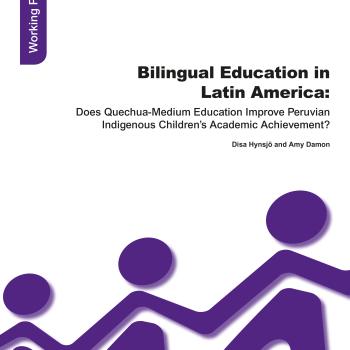
This paper uses Peruvian school-level data from the Young Lives international study of childhood poverty to investigate the effect of Quechua-medium instruction on academic achievement. We estimate an education production function and find that indigenous children who attend Quechua-medium schools achieve mathematics scores 0.54 standard deviations higher than indigenous children who attend Spanish-medium schools. We find weak and inconclusive evidence that indigenous children who attend Quechua-medium schools attain higher language test scores. There is no evidence that these effects are caused by quantitative or language achievement prior to entering school. Our findings suggest that indigenous-language-medium education for Latin American indigenous children may play a role in ameliorating the indigenous test score gap.

This paper uses Peruvian school-level data from the Young Lives international study of childhood poverty to investigate the effect of Quechua-medium instruction on academic achievement. We estimate an education production function and find that indigenous children who attend Quechua-medium schools achieve mathematics scores 0.54 standard deviations higher than indigenous children who attend Spanish-medium schools. We find weak and inconclusive evidence that indigenous children who attend Quechua-medium schools attain higher language test scores. There is no evidence that these effects are caused by quantitative or language achievement prior to entering school. Our findings suggest that indigenous-language-medium education for Latin American indigenous children may play a role in ameliorating the indigenous test score gap.

